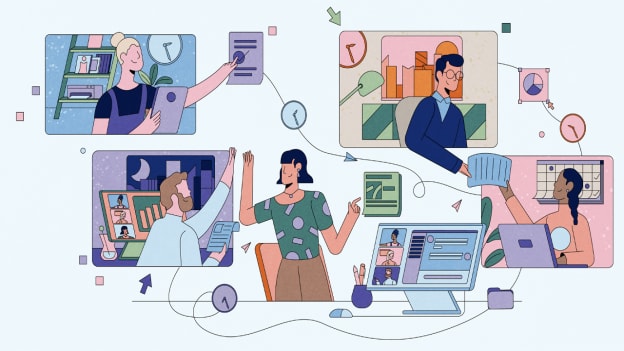Episode 5: BeNext Radio Show - The Virtual Team Leader

Episode 5 of the BeNext Radio Show is all about how to be a better virtual team leader. Here, our host Pilar Orti is joined by our Virtual Learning & Development Manager, Cindy Scholts, to discuss how shifts in workplace models have created a new set of considerations for coaches and leaders, specifically when it comes to leading, learning and navigating challenges in a hybrid world. This conversation was featured in a webcast as part of the Leadership & Coaching in the Hybrid World Certification program, opening on June 7th 2021. Pilar will be a Lighthouse Keeper on this course, delivering the masterclass and guiding learners through the journey. To enroll and find out more, click here.
How did 2020 transform the way we think about virtual leadership?
“For one, it allowed people to experience something they’d never experienced before,” Pilar explains, “which was working away from each other and having to continue collaborating away from each other. Some people had to experience working from home for the first time and this had made people really rethink, ‘what do really I need to do my best work?’” We began to question if we really needed to be physically near our colleagues, or if what we really needed was to feel emotionally close to them.
Beyond that, in light of witnessing a new flexibility around where we work, many people began to question what else could be changed about the hours we work, the way in which teams are organised and decisions are made. While we’re still dealing with the shocks of these changes, what we’re left with is the space to really reconsider every aspect of how, when, where and why we work the way we do.
How does the role of the leader differ in distributed teams?
In a hybrid, virtual or distributed context, the role of the leader is to think of what they can do to help their teams be more autonomous, self-organising and independent, says Pilar. “What is the information they need about each other? What do they need from me that they can access at any time?”
In this respect, too, it’s the role of the leader to decide which technologies best enable collaboration and communication. Where there can be a tendency to view tech as something that makes us less human and somehow less connected to each other, as Pilar points out, in a virtual context, technology really is the space we occupy. As we touch upon in the program, virtual or hybrid work is conducted through a mix of synchronous and asynchronous work.
“If we’re working in a team where our tasks are heavily interdependent and where I can’t start my task until you’ve finished yours, I want to know what stage you’re at,” Pilar says. “If you have a very simple system of visible workflow through applications like Trello, Asana or a spreadsheet, at any time of the day I can go and see what stage you’re at on that job.” Technology can and should enable connectedness and collaboration. It’s the role of the virtual leader to facilitate the use of these technologies and role model the most effective ways to use them.
As Pilar points out “collaboration is not real time discussion. Collaboration is knowing what we’re doing, being clear about our roles within that so we have clarity. There is an element of discussion to-and-fro but there’s also an element where people need to go off and do their jobs and do their tasks.” By understanding the different stages of collaboration, we can use the digital space and find the technology to suit each stage best.
Giving people what they want and need applies to training too. What is the best way to find out what people want and need? Ask as many people as you can and explain how it’s going to help them. Incentivize people by letting them know who will be at the session, who they will have the chance to talk to and what specific skills they will pick up.
How can we assuage fears around visibility in a virtual setting?
According to a new report by Beamery, more than a third of professionals feel ‘undervalued’ or ‘isolated’ due to their organisations’ remote work approach and 64% believe a lack of face time with their employer during COVID has inhibited their chances of gaining a promotion. “The answer to that problem,” Pilar explains, “is to have other ways to give people visibility in an organisation. Can we talk about them in meetings with other people? Can we have a team newsletter that we send out? Can we have open sessions once a month where you can come to our team and we’re just there for you. You ask us stuff and we’re there for you.”
To hear more about leadership and coaching in a hybrid world, read about the BeNext Cohort Certification Program
Download the episode through Spotify here.
Download the episode through Apple here.
Download the episode through Google here.






